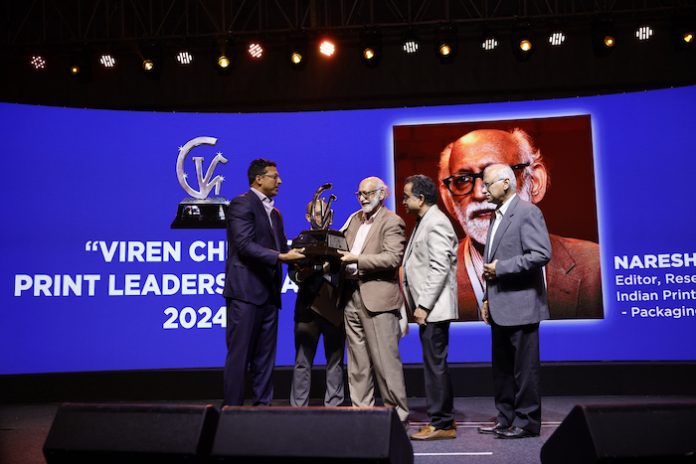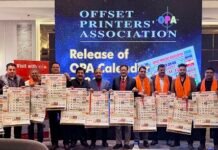
We reproduce below the brief address by Naresh Khanna on receiving the Viren Chhabra Print Leadership Award from the All India Federation of Master Printers in Mumbai on the evening of 8 February 2024.
“Good evening colleagues and friends, and thank you for the honor. I am asked to speak about our industry and a bit about its future. Naturally, I will speak a bit about our recent past in which I knew Viren Chhabra.
“I met Viren Chhabra in 1975 and marveled at his ability to keep the diverse associations of your Federation together. He brought dignity and respect to the printers with his self-belief and his outward-looking talent for projecting our industry on international platforms. I also knew him as a letterpress blockmaker and printer and can only share that it was The Statesman’s high contrast and crisp reproduction that evoked the great impact of our generation’s iconic photojournalists.
“As a newspaper printer, Chhabra carried the responsibility of getting the truth out, not only answerable to the publisher and owner but also to the country, to ensure that the freedom of expression guaranteed by the constitution is maintained and not censored by despotic whim. A printer knows he is liable even for printing the truth – being questioned, threatened and harassed by the state is part of the job. One should be ready to be jailed and for trips to courts across the country to back up one’s authors, journalists and editors. However, one must try and do the job and also stay out of jail.
“An incident in Chhabra’s career as the newspaper’s publisher and printer is recounted by Sagari Chhabra in her 2015 book, “In Search of Freedom.” She writes, about the emergency declared by Indira Gandhi on 26th June 1975 when civil liberties were suspended, the press was censored, and many opposition members, journalists and trade unionists were imprisoned.
““They came with a warrant of arrest for my father, who was responsible for printing The Statesman and The Seminar, both critical of the Emergency. She quotes him, ‘It was late in the evening when the policeman came to my office. He was in uniform and showed me the warrant of arrest. I called up my boss who said, “It is late now. If they take you, we will try and get you bail tomorrow. Good luck.”
“‘I thought fast, knowing no bail was possible during the Emergency. I started showing him the body of work that I had printed and published. One of them was a book, A Day in the Life of Indira Gandhi, by Raghu Rai a staff photographer who had documented Indira Gandhi both at home and in the office. The policeman left with the book but without me.’”
“I have been writing about technology and the economy for more than 45 years and while there has been great progress in both, I believe my readers and I continue to share the same optimism about the country’s economy and our belief in technology as a great leveller. Despite many constraints, those who have committed to the chip and software future that drives mechatronic devices have been rewarded by modern prepress, muliticolor presses, automated finishing, binding and converting.

Photo AIFMP
“And many of our colleagues have grown well enough to attract the educated next generation, including women, into the family business. Their insistent self-belief in what we do has rubbed off on the younger lot. Family business, the so-called ‘middle business’ is an important contributor to economies everywhere. As it is poised to play a significant role in our publishing, printing, and packaging industries, it can continue to be one of the engines of Indian modernity.
“Although by keeping the presses rolling, printers expand the freedom of expression necessary for scientific and civilized discussion, senior printers have told me – ‘We are in business no matter who is in power.’ As one of the largest industries, and one that generates one of highest levels of private employment, unlike in most other countries, printers in India are not decreasing in number.
“For them, new technologies present opportunities and access; to create livelihoods even as they serve education, culture and commerce in every sphere. The Indian publishing, printing and packaging industry is growing well, although not at the high double-digit levels as some are led to believe especially by unverified data on the Internet. IppStar’s research over the past 25 years has been able to validate the actual extent of this growth.
“There is still great headroom for growth and the key impetus will come from education – for print, the innovation economy and the country. Expenditure on education will grow no matter what government is in power. Structured education using books and reading and writing will keep increasing. The ongoing collapse of the Edutech bubble has proven that there is no shortcut and no substitute for brick-and-mortar schools – and paper and ink. Education is an inescapable dynamic of society and economic growth and there is every chance that printing, and even the local manufacture of publication papers may suddenly become a priority – for those in power.
“For the packaging industry, which is already recognized as a huge vector in the modern consumer economy, the great challenges are in brand protection or anti-counterfeiting, supply chain condition monitoring, customer engagement and sustainability – from design, waste collection to lateral recycling. It is clear that changing habits and culture are not as likely to work, as bringing about change with technology.
“The keys to the survival and growth of print businesses lie in efficiency, which will come from automation, technology, and scaling. However, merely adding machines is not necessarily the best use of capital. Focus on the bottlenecks in your business, on reducing the work in progress and inventory, on the constraints in your processes and invest there. As one of your colleagues recently wrote on his LinkedIn page, even your press and ancillary equipment should be counted as unsold inventory.
“Actively partner your customers in monitoring consumption. This approach can also make educational outcomes more efficient – when the right book, lesson or quiz reaches the right student in the right seat in the right school within minutes, hours or days of ordering, instead of being printed in unnecessary quantities and then stacked in warehouses and godowns.
While every new technology that we have seen in the last 50 years has helped in the dissemination of knowledge and print, we are threatened today by misinformation, counterfeiting, hallucinations, deep fakes and alternate reality fields with its leading edge called artificial intelligence. Keep in mind that printers are the both the manifestation and guardians of human intelligence and authenticity, their presses are the levers of human knowledge and development.
“Keep in mind, that we have been using automated or computerized expert systems right from the 19th century when we created machines that could sort set lines of metal types back into their type-cases, and then in our algorithms for typesetting, color separation, enhancement and page assembly. Our tools are developed by the highest order of inventors and scientists – who work alongside those in space and satellite imagery.
“With what is being called artificial intelligence, we face a higher order of number crunching for many tasks including those that were considered creative or those attributed to the right brain. It will be interesting to see what huge amounts of number crunching or left brain activity can add not only to our repetitive tasks but to our creativity and our intuitive and right brain activity, including decision making. Keep in mind that the next new thing may not just be a product or a technology but an ecosystem that we can bring to our customers.
“Remember that our trade, business and our technological understanding have never been neutral! We have always used these for the collective and collaborative understanding of our universe and the progress of humanity. From an industry that grew by publicizing the anti-colonial and freedom struggle, and quickly adapted to nation-building since independence, we now face a larger task and opportunity – that of not only bringing prosperity and equity nationally but of looking at global needs and challenges.
“Of contributing to the development and judicious use of the tools that are needed by humans to remain authentic and creative not only to enhance their culture and economies, but to contribute to the saving of the planet – from war, famine and tyranny.
“Thank you.”












